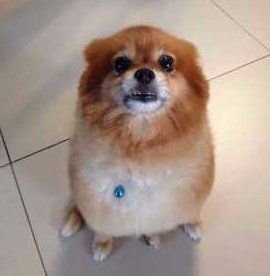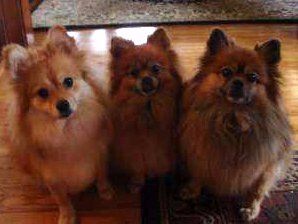Sit - Teach
PetPom

The
Pomeranian
Information
Center
How to Teach a Pomeranian to Sit

Cookie, 4 years old
Photo courtesy of owner: Regina
Overview of Teaching a Pom to Sit
Basic command training is the foundation for having a well behaved dog and a Pomeranian that has self-confidence.
Teaching a Pomeranian to sit is often the first command that is taught. However, even some adults need to learn this. Why? Well, some dogs are not officially taught any commands, however over the course of time, a Pom may catch on to some words such as 'Come' and 'Nooooo' (usually meant to actually be the command of 'Wait').
Sit is the basis for just about every other command. Once this is mastered, it is must easier to train a Pomeranian to 'Stay' or to teach the "Down' command.
Ideally, you will want your Pom to sit any time a meal or snack is given. This makes for a more well-behaved dog and importantly, one that respects you.
This is really important in regard to your Pomeranian seeing you as the leader; as proper hierarchy is key.
Before You Begin
While the command of "Sit' may seem easy, if your Pomeranian does not know this one yet or has struggled with it in the past, you'll soon find out that asking a dog to sit and having him follow this request is downright impossible if it is not taught in the right way.
So, before you run to get your Pom (though we do love your enthusiasm), let's go over some important things to keep in mind before you start.
1) Saying 'Good job!'
is important even if full success is not immediately reached. For a Pomeranian to stay motivated enough to pay attention to lessons, he needs to feel good about what he is doing… Even if he is not doing things perfectly. Don't worry, he soon will. However, until that time, while you are teaching your Pom to sit, never let him feel that he is wrong more than 3 times in a row.
If he is having trouble, start at Step One so that you can tell your Pom that he is doing good. You can try Step Two once he feels confident about the first step.
2) Timing -
Poms can become distracted easily and may not always be in the mood for training. However, if you choose a time when your Pom is rather bored, he will be more open to learning how to sit. If he's expecting a walk, food or any other element that causes excitement, he will not be able to focus. Choosing a 'down time' for this sort of interaction and acting enthusiastic can often cause a Pom to really enjoy command training.
3) Your outlook counts for a lot -
You probably already know that your Pom can pick up on your moods and the vibes that you send out. So, when you are trying to teach your Pom to sit, if you silently sigh or inwardly shake your head, your Pom will know you're doing that. And that makes a dog feel defeated. You want to make this fun! And you want your dog to feel good about himself. So, never train your Pom unless you are in a great mood and will be able to display true enthusiasm.
4) Resist the urge to move your dog into position
- This mistake is done by the majority of owners who assume it is much easier to show a Pomeranian how to sit by physically helping him sit as opposed to other means. But this will backfire.
Results will be temporary and your dog will never learn this command as it is meant to be learned: a fast, essentially involuntary reflex when the command word is spoken. With these instructions, very slight manipulation may be needed, but pressing on your Pom's rump to force a 'Sit' accomplishes nothing.
5) Do not say the word 'No'.
You may have to place some tape on your mouth, since uttering 'no' is so easy to do; however this is not a good idea when teaching a puppy or dog. When a Pomeranian is told 'No' while training for commands, he can very quickly feel defeated.

Cindy Lou, Dahila & Opahla
Photo courtesy of owner Paul
The goal is to make command training fun and something that he looks forward to. For this reason, you'll want to use the word, "uh-oh" in a light-hearted way.
6) There has to be a release word.
Dogs need to know when they can move out of position. You'll lose the element of control if your Pom has to decide for himself just how long it is that he should sit to make you happy. Most trainers use the word 'Okay' since it is a short command that canines understand very well.
7) You'll need to use treats as rewards in the beginning.
Choose a treat that is special; not one that you would give to your dog anyway at some point in the day. After some time, your Pomeranian will know to sit just by muscle memory due to repetition and food rewards will not be needed. Until then, have a treat in your hand, ready to give to your Pom at the exact moment he is sitting.
8) Have a set schedule.
You can't teach your Pomeranian to sit if you do it for 15 minutes twice a month. However, when you have a good routine of perhaps a session twice per day, each day, your Pom can learn this in as little as 2 weeks. A session should last about 10 minutes. End things on a good note, so that your Pom will consider the event a success and want to try again then following day.

"Woof,
rufff,
rrrr...grrr... UMPHF!"
Translation:
"Tweets for treats...? ... or share for... ahh... a pear???
Well, you get the gist! Show me some love & share this site before you read on."
Share
Tweet
Share
Mail
The “Sit” Command
For teaching a Pomeranian to sit, we are going to use a condensed excerpt graciously given to us by Faye Dunningham from her top-rated book: The Well Trained Puppy: Housebreaking, Commands to Shape Behavior and All Training Needed for a Happy, Obedient Dog.
The Goal
The goal of this command will be that when the command “Sit” is given, your dog will sit squarely and firmly down on his hindquarters and remain in that position until you give the “release” word. It should be noted that a Pomeranian should not be expected to sit in this way for long periods of time.
What You Should Know About this Command
Puppies as young as seven weeks old can start learning this command and it is often the first command that a dog is taught. This command is the foundation for essentially all other commands. Have two training sessions spaced apart, with perhaps one in the morning and one in the early evening. If morning is not a good time for you, you can practice once in the early evening and once a couple of hours later but not within an hour of “bedtime”.
Treats play a huge role in enticing your puppy to follow this command. Therefore, your dog should be hungry when you do these training sessions. However, be sure that your dog is not starving for dinner as he will be too focused on wanting to devour a full meal and not be able to stay focused. A dog in training should be hungry enough that treats are desired.
While each puppy has his own learning rate, if the training is done as often as described above and in the way that is explained ahead, your puppy may be able to master this command in one to three weeks.
Remember to end on a “high note” when your puppy is doing well. Give praise for “good attempts” and work to keep the morale high. Finally, remember to never say “No” and to say “Uh-oh” instead.
1 – Choose a room that has little distractions. You may also wish to do this outside, but again it should be an area with few (or no) distractions.
2 – Have a treat in your hand, and also some in your pocket.
3- Have your dog on leash.
4- Stand or kneel right in front of your dog, holding a treat in your hand a little higher than your dog’s head.
5- Slowly move the treat straight back over your dog’s head. This should cause his nose to point up and his rump to drop down to the floor.
If his rump does not drop, keep moving the treat straight backward toward his tail. The very moment that his rump touches the floor, give him the treat and signal the desired behavior by saying, “Good Sit!” in a happy voice.
Note:
It is important to say “Good SIT” and not “Good boy” or “Good girl” because saying “Good Sit!” reinforces the command, allowing your dog to have a better understanding of why he is being rewarded.
6- Once your dog has shown you that he sits when commanded in this way, move on to the stage of waiting a few seconds before giving him the reward. Remember to only reward while your dog is in the correct position of squarely sitting on the floor. For all attempts, only enthusiastic praise is given to encourage the dog to keep trying.
7- Slowly increase the amount of time that you wish for your dog to sit. Start with just a count of three seconds. When you are ready for him to come out of the “Sit”, say “Okay” (the release word). Say it as if you are saying, “You are free!” and use a hand motion to send that message.
When your dog moves out of the sitting position, offer him praise and a pat. Do not offer a treat, but do make it clear that you are happy that he not only sat, but came out of the sit when you released him with the word of “Okay”.
You may also be interested in:
Pomeranian puppy care
- Start things off right by having a solid foundation of routine care.
How to brush a Pomeranian
- This super thick double coat needs to be properly brushed to keep a Pom looking like a 'ball of fluff'.
Shampoo for Poms
- The wrong product (even those touted as great for other breeds) can weigh the coat down, making the fur look super flat.
Pomeranian shakes and shivers
- There are several reasons why a Pom of any age may shiver and it's important to take action right away.
New Fun:
Find out your Pom's Chinese zodiac animal sign. It's a fun way to get better insight about your Pom's traits and personality.
If you email photos to us, you agree that PetPom is given free copyright to use at our discretion. We will always credit the photo to the name of the Pom's owner(s) if it is supplied.
Email: Contact@PetPom.com
All text, images and artwork protected by US and International copyright laws. All rights reserved. Copyright PetPom.com
We are a participant in the Amazon Services LLC Associates Program, an affiliate advertising program designed to provide a means for us to earn fees by linking to Amazon.com and affiliated sites.


